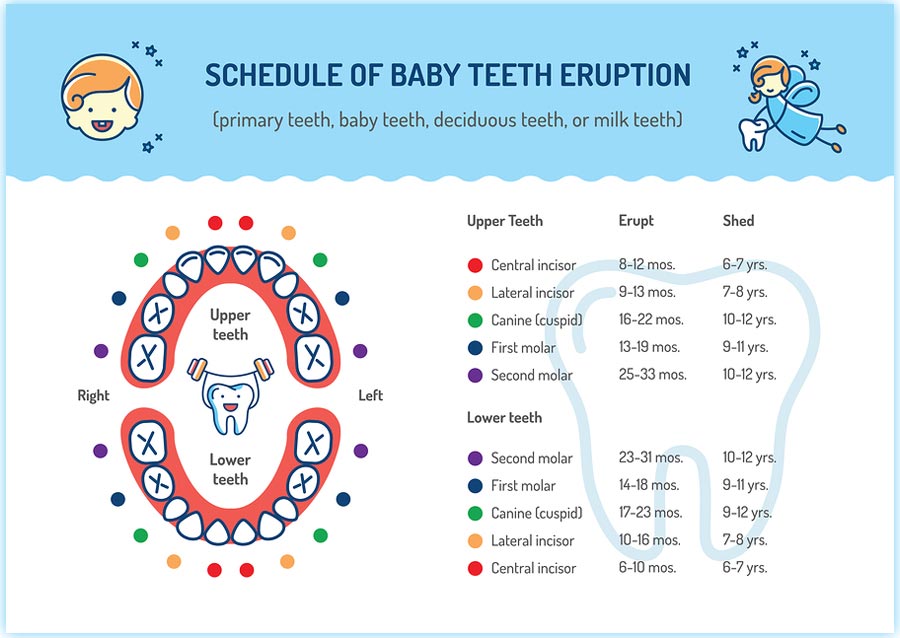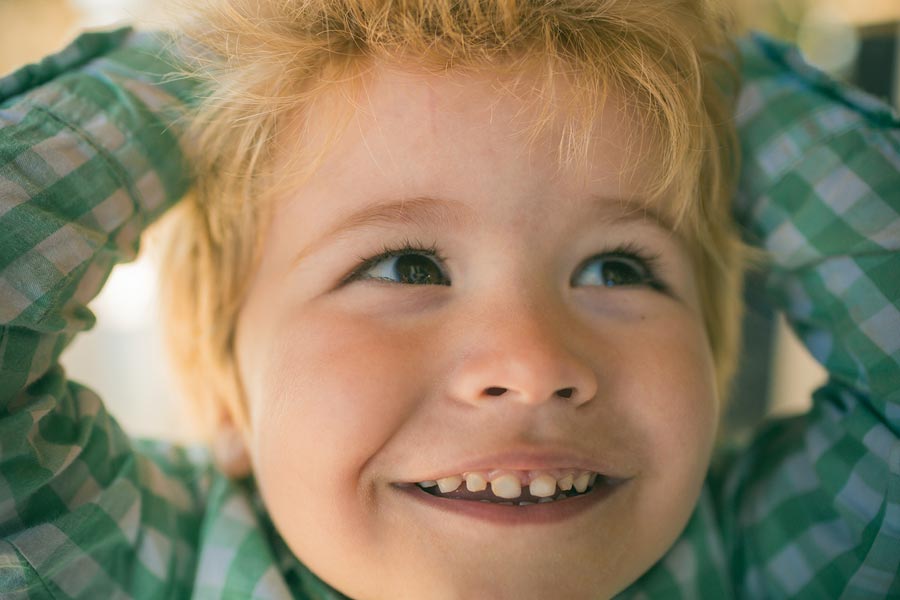Tooth Eruption Chart for Baby and Adult Teeth

The first thing you should notice when inspecting a tooth eruption chart for both baby and adult teeth is that adults have more teeth than babies. In fact, they have twelve more. Babies’ mouths are quite smaller than an adult mouth so there is only so much they can accommodate and still have reasonably sized teeth.
The next thing to notice from this chart is that there are several different types of teeth in the mouth and the arrangement of them is both symmetrical and mirrored between the top and bottom jaw. In the center of the jaw are two sets of incisors: central and lateral (lateral meaning “next to”). These four teeth are wedge-shaped and meant for biting. On either side of the incisors are the canines which come to a single point. These are used for ripping or tearing at foods that are tougher and cannot be easily “sliced” through with your front teeth, such as meat. The adult jaw then includes two sets of pre-molars called bicuspids. These are a cross between molars and canines in that they are larger and used for chewing, but also come to several points and can be used for ripping like canines. Finally, both babies and adults have several sets of molars at the back of their jaws. Molars are wide, flat, and blunt and primarily used to grind food down as we chew.
The variety of shapes and their different purposes are what allow us to survive as omnivores. If you look at the teeth of herbivores and carnivores you will see that their teeth tend to be mostly or all of one type. In the same way that the teeth of these animals helps dictate what they eat, it is important to know the status of your baby’s oral development so you can give them the proper foods. For example, just because your baby has had their first two incisors come through does not mean they are ready for large pieces of food that must be chewed and broken down.
So, let’s take a look at the timelines that these charts can give us. As previously stated, you can expect to see your baby’s first teeth erupt after six months of age. Usually, the lower central incisors will be the first to show, followed by the upper central and lateral incisors and then the lower lateral incisors. Around their first birthday, babies have, on average, had their eight front teeth appear. Note that all of these times are presented in ranges. It is perfectly normal for things to take a bit longer and not necessarily come in following this sequence. If your baby only has two or three teeth showing by their annual checkup it is not something to be concerned about but can certainly be mentioned to their pediatrician. By the time they are 18 months old, most babies will have had their full set of first molars erupted and might also start seeing their canines. Around the second birthday, the last of the baby teeth should appear in the form of their second molars.

Around the time that they begin to lose their baby teeth your child will have their set of first adult molars erupt, so while they are losing and replacing teeth they are also growing entirely new ones. This is because their jaws have finally grown large enough to accommodate a new set. They will not get their second adult molar, also known as the 12-year molars, until around the time they have finished losing their baby teeth.
As your child grows their mouth is continually shifting and trying to squeeze in as much as it can in the way of teeth. After erupting, things can grow in at odd angles if there is a lack of space in the jaw and could result in dental problems. It then takes a few years for the jaws to be large enough to accommodate the final two sets of molars. In fact, most people end up taking out the final set of molars, also known as the wisdom teeth, before they even erupt. This is because wisdom teeth tend to get impacted or start to grow in wrong due to lack of space in the jaw.
Though this chart can be very helpful to understand what to expect, do not worry if your child is a little early or late or out of sequence on when their individual teeth erupt. Eventually, they will all come in and if there is anything unexpected then their pediatrician or dentist will catch it before it becomes a problem. Relax and enjoy these fascinating developmental milestones.
“Don’t be surprised if there’s significant variation between kids in the same family. It’s not unusual for youngsters to vary by up to two years when it comes to the development of primary and permanent teeth.”
Relate Posts to Read:
Crooked Baby Teeth: What You Need to Know
Medically Fact-Checked & Written by Our Dental Editorial Team
You can read more about our editorial guidelines by clicking this link and learn more about the Emergency Dentists USA editorial team here.


